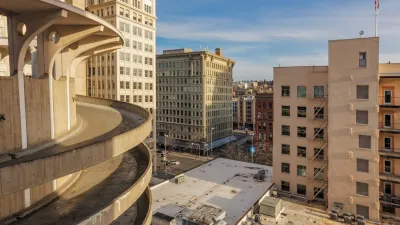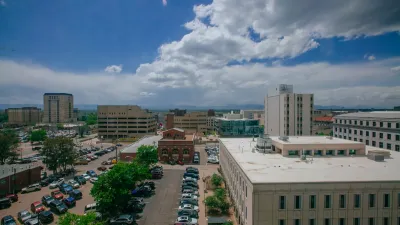This 16-minute radio interview of Forbes writer Micheline Maynard and Cornell urban planning professor Michael Manville explores how and why to redesign cities to make them less auto-dependent to match reduced driving.
Host Jeremy Hobson's first guest is Micheline Maynard, editor of the journalism project, “Curbing Cars: Rethinking How We Get Around.” She explains the cultural shift away from cars, particularly with millennials who accounted for a notable part of the shift in the May, U.S. PIRG, "New Direction" report that detailed the reduction in driving and implication for changes in U.S. transportation policies (also discussed here).
Hobson's second guest, City and Regional Planning Professor Michael Manville of Cornell University, explores how accommodating cars has reshaped American cities, with a particular focus on parking requirements and their impact on low income residents.
“If you have zoning codes that force developers to provide housing that comes with parking spaces, what you are implicitly saying is that it is illegal to build housing explicitly for people who are too poor to own cars”.
He's also fond of the woonerf streets in Copenhagen [actually a Dutch word] where all road users must learn to co-exist. "These streets have little signage, and no demarcations, such as lanes. Instead, pedestrians, cars, bikes and other vehicles have to be attentive and make their own decisions about how to occupy and share space together. While it sounds chaotic, Manville says that it’s actually much safer."
Hobson's final question allows Manville to explain how he sees cars fitting into American cities, and how cities can accommodate cars without reshaping themselves to do it. It's clear from his summary statement that he is not "anti-car", far from it; he appears to like driving. It's the car subsidies that he advocates changing.
HOBSON: So big picture, Michael Manville, are we moving toward a society that is less focused on cars, and are we ready? Are cities ready for what that means for them?
MANVILLE: I think that cities should be organized in a way that encourages people to drive less. And we should do that for environmental reasons; we should do that simply for efficiency reasons because a lot of our cities are terribly congested. So I think that it's up to cities to take the lead and have these policies [e.g. parking minimums] that say, you know, we're going to make it so that we no longer sort of subsidize driving, but rather we're going to encourage other modes of travel and, you know, make driving easy because driving is great but also make it sort of pay its full way.
FULL STORY: As Americans Drive Less, What Does That Mean For Cities?

Planetizen Federal Action Tracker
A weekly monitor of how Trump’s orders and actions are impacting planners and planning in America.

Map: Where Senate Republicans Want to Sell Your Public Lands
For public land advocates, the Senate Republicans’ proposal to sell millions of acres of public land in the West is “the biggest fight of their careers.”

Restaurant Patios Were a Pandemic Win — Why Were They so Hard to Keep?
Social distancing requirements and changes in travel patterns prompted cities to pilot new uses for street and sidewalk space. Then it got complicated.

Albuquerque Route 66 Motels Become Affordable Housing
A $4 million city fund is incentivizing developers to breathe new life into derelict midcentury motels.

DC Area County Eliminates Bus Fares
Montgomery County joins a growing trend of making transit free.

Platform Pilsner: Vancouver Transit Agency Releases... a Beer?
TransLink will receive a portion of every sale of the four-pack.
Urban Design for Planners 1: Software Tools
This six-course series explores essential urban design concepts using open source software and equips planners with the tools they need to participate fully in the urban design process.
Planning for Universal Design
Learn the tools for implementing Universal Design in planning regulations.
Heyer Gruel & Associates PA
JM Goldson LLC
Custer County Colorado
City of Camden Redevelopment Agency
City of Astoria
Transportation Research & Education Center (TREC) at Portland State University
Camden Redevelopment Agency
City of Claremont
Municipality of Princeton (NJ)





























